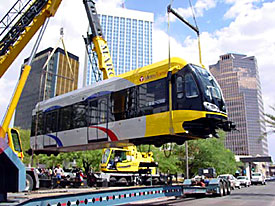 |
|
Photo courtesy of Citizens For A Sensible Transportation Solution
|
Tucsonans had the opportunity over the summer to preview a full-scale model of the vehicles being proposed as part of the light rail initiative in downtown Tucson.
|
|
|
By Greg Holt
Arizona Daily Wildcat
Friday, October 24, 2003
Transportation initiatives on the upcoming election ballot could have a direct impact on the UA and the Rio Nuevo project.
About 50 people attended a forum last night in the ILC to discuss the impact propositions 200 and 201 could have on the UA and the city of Tucson.
Proposition 201 calls for a number of measures to improve transportation systems in Tucson, including vast improvements to the Sun Tran bus service, the construction of a light rail system in central Tucson, and the extension of the Old Pueblo Trolley from the UA through downtown.
Proposition 200 concerns measures to fund these programs, including increasing the city sales tax a third of a percent and increasing the sales tax on construction contracts by four percent.
Both of these propositions must pass for the programs to be implemented.
"Rio Nuevo can't work without this plan. Not a single downtown in this country has been revitalized through the car, you need a good transportation system," said Stephen Farley of Tucsonans for a Sensible Transportation Solution.
"It needs the extension of the trolley and the light rail. This plan will be an enormous economic generator for Rio Nuevo," Farley said.
Rio Nuevo is a proposed downtown revitalization project.
John Dougherty of the Tucson Chamber of Commerce, who opposes the initiatives, said he is concerned that construction costs needed to install the light rail system on East Broadway Avenue would eat up the funding for Rio Nuevo.
"Because of the amount of money need to make changes to Broadway, and if federal funding falls through, there will be no money for Rio Nuevo," Dougherty said.
Farley said that the light rail system, which has planned stops along East Sixth Street, would relieve traffic congestion in the university area.
"In Salt Lake City, so many students and faculty have used the light rail that the University of Utah has torn down parking garages and built classrooms in their place," Farley said.
Dougherty's main criticism of the light rail system is that payment for the transportation system would be unfairly distributed across Tucson because a city-wide sales tax would be imposed when only those in central Tucson would benefit.
"This plan does not take into account that most of Tucson will not be served by this rail system. Why pay for something you won't use," Dougherty said.
Dougherty proposes a regional transportation system where everyone in the greater Tucson area will pay for a transportation system in proportion to how much they directly benefit.
"People outside Tucson will receive bus service with this plan, and we don't think they should be getting a free ride," Dougherty said.
Farley contended that something must be done now to correct for Tucson's inadequate transportation system, considering Tucson's rate of growth.
"This city is all about cars because we haven't been given any other options," Farley said. "Some say we don't need these programs now, but then when? We will have a million people in this city when construction on the light rail starts in 2010."
Joy Herr-Cardillo of the Arizona Center for Law in the Public Interest, who supports the initiatives, said that the proposition has been written very specifically so that city politicians cannot change where the money actually goes after the proposition has been passed.
The proposition calls for $50.5 million to be spent per year over the next 20 years. Forty percent will go to Sun Tran, 22 percent will go to the light rail system, 20 percent will rebuild neighborhood streets, 10 percent will rebuild sidewalks and bike paths, six percent will extend the Old Pueblo trolley through the downtown, and two percent will be used to hire more traffic police.
Since the light rail plan also depends on funding from the federal government, Dougherty is concerned that this money will not come through and Tucson will have to pick up the tab or give up on the project.
"Can we expect the Bush administration to fund these sorts of programs? We can't expect our needs to carry any weight when we have no congressman on the transportation committee," Dougherty said.
Herr-Cardillo said that the construction of the light rail has been pushed back to 2010 to buy time to secure federal funding, and that the economic benefits to the light rail would be substantial.
"We've seen in every instance that development follows the light rail and grows around it," Herr-Cardillo said, citing evidence from other Western cities with light rail systems.
Dougherty believes that a comprehensive transportation system should be funded by a gasoline tax rather than a sales tax, although this would require a change to the Arizona constitution. The constitution states that gasoline taxes can only be used to build and maintain roads.
